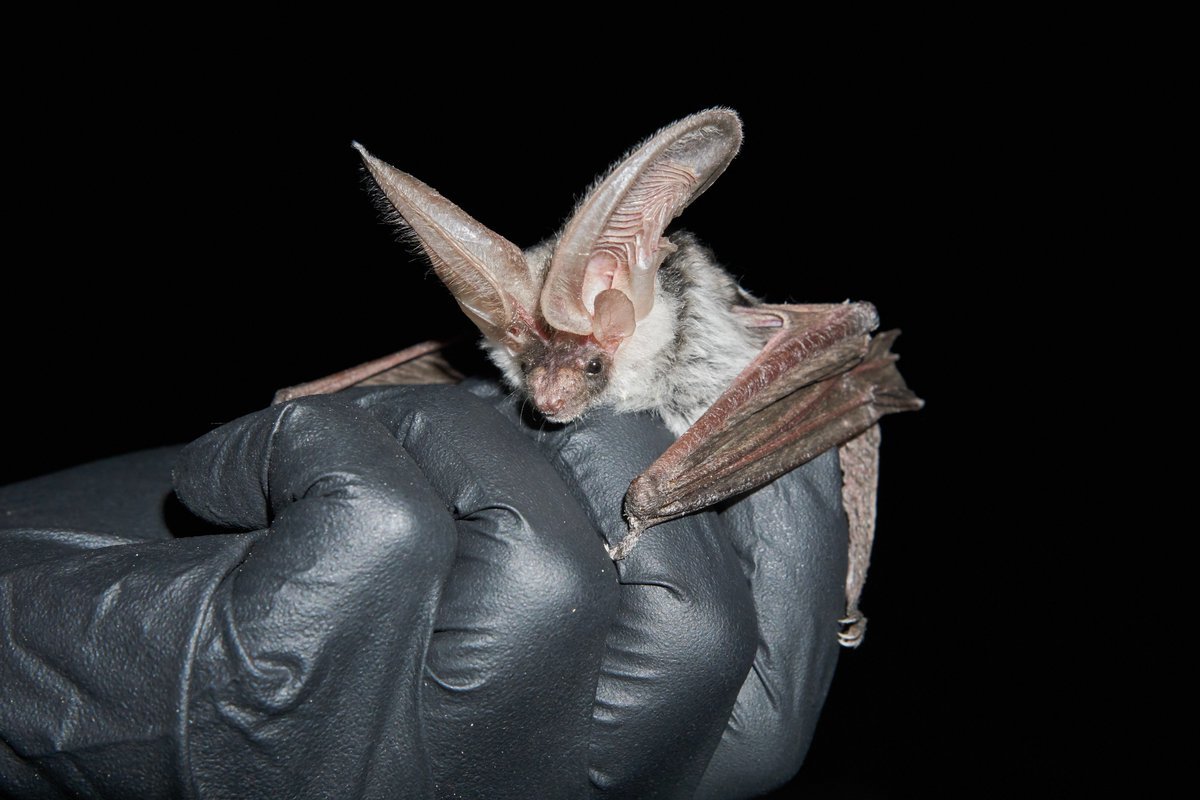Spotted Bat: Euderma Maculatum

One of America’s most striking mammals is the spotted bat. Its transparent pink ears are the largest of any bat found in the United States (nearly as long as its body).
The spotted bat is known to inhabit a fairly wide range across central-western North America from southern British Columbia to northern Mexico.
Just 35 spotted bat specimens were known to science from the first scientific discovery in 1891 until 1965. It is one of the least recognized animals in America even now, but the rarity with which it is observed probably does not reflect its actual status in nature.
The spotted bat is difficult to observe and unlikely to be affected by humans due to its habits and range of roosting sites high in cliff crevices. This bat appears to feed on strictly moths, which it captures high above the ground. 1Go To Source batcon.org -“EUDERMA MACULATUM”
Learn More: Collection Of Bat Species
Physical Characteristics Of The Spotted Bat
Wide ears with a pinkish tone make the spotted bat (Euderma maculatum) a distinguishable and unique species.
This rare bat is colored with two broad white spots on the animal’s shoulders, one white spot on its rump, and the body is jet-black in color. The fur is snow white on its underbelly, and the wings are pink. 2Go To Source desertmuseum.org -” Animal Fact Sheet: Spotted bat”
Spotted Bat Behavior
For the spotted bat species, very little is known. For example, in the 100 years from the time of its discovery to 1990, only 14 spotted were found in California. It was once considered to be rare, but since then, the number of sites where spotted bats have been found has tripled.
Usually, only one is visible for any given location because spotted bats are well scattered, separated by distances of 750-1000m from each other.
To engage with other bats, they use vocalizations. An apparent territorial conflict involving vocalization and physical communication has at least one documented account.
In most research, these bats forage no more than 10 km from their daily roost. Spotted bats fly from their roosting sites in elliptical patterns when foraging.
This species appears to be roost faithful; they return to the same diurnal roost every night in the summer. Their activity becomes less predictable in Autumn.
Compared to other bat species’ foraging behavior, spotted bat foraging behavior does not seem influenced by the amount of moonlight at night.
These bats may have a seasonal elevation migration from high elevation habitats in June and July to lower elevations in August, in addition to the nighttime migration to foraging sites. 3Go To Source animaldiversity.org -“Euderma maculatum spotted bat”
Reproduction Of The Spotted Bat
As is the case with most bats, in the late spring or early summer, Euderma females bear one pup per year. In late summer and fall, males in reproductive condition have been found, suggesting that when they are fat and in peak physiological shape, Euderma may mate late in the feeding season.
The young will then be born in early winter, but the physiological specialization of delayed fertilization has evolved for many temperate zone bat species. During hibernation, the female sequesters the sperm so that sperm does not reach the egg until spring, and during peak insect activity.
A newborn Spotted Bat is around the size of a green grape, but it is only about 1/4 of the weight of the mother at 4-5 grams. 4Go To Source wildlife.state.nm.us -“WILDLIFE NOTES”
Habitat Of The Spotted Bat
Spotted bats are typically found near a permanent water source in wetlands, riparian, rock, hills, deserts, shrubland, grasslands, or forest habitats. They primarily roost in caves and rock crevices but can also use mines, caves, and buildings as roost sites on occasion.
Spotted Bat Range
Their range is considered to stretch from Montana south to central Mexico, including arid areas of previously unrecognized Nevada, Wyoming, Colorado, and Utah in the western US. Although the distribution across this range is very patchy, the species may be locally common.
Diet Of The Spotted Bat
The spotted bat mostly feeds on insects, making it an insectivore. Moths are the preferred food of this bat and account for most of the spotted bat diet. This bat will rip off the wings of a moth and only eat the insect’s abdomen.
4 Favorite Meals For A Spotted Bat
- Moths
- Flies
- Beetles
- Grasshoppers
Spotted Bat Conservation
Historically, due to its roosts’ remoteness, the spotted bat has suffered little impact from human disturbance. Still, reservoir impoundment and a recent rise in recreational rock climbing may impact the species in local circumstances.
The spotted bat may be influenced by large-scale pesticide programs to monitor Mormon crickets and grasshoppers by decreasing prey supply. The species may also be affected by the loss of foraging habitat (conversion of desert wash vegetation and/or meadow grazing). 5Go To Source tpwd.texas.gov -“Spotted Bat (Euderma maculatum)”
Sources:
- Bat Conservation International. “Euderma Maculatum.” Bat Conservation International, 1 July 2020, www.batcon.org/bat/euderma-maculatum.
- “Cactus Wren Fact Sheet.” Arizona Sonora Desert Museum, www.desertmuseum.org/kids/bats/Spotted%20bat.php. Accessed 11 Dec. 2020.
- New Mexico Department of Game and Fish. “WILDLIFE NOTES Spotted Bat.” New Mexico Game And Fish, www.wildlife.state.nm.us/download/education/conservation/wildlife-notes/mammals/spotted-bat.pdf. Accessed 11 Dec. 2020.
- Hussain, S. 2000. “Euderma maculatum” (On-line), Animal Diversity Web. Accessed December 10, 2020 at https://animaldiversity.org/accounts/Euderma_maculatum/
- “Spotted Bat (Euderma Maculatum).” Texas Parks And Wildlife, tpwd.texas.gov/huntwild/wild/species/spotted. Accessed 11 Dec. 2020.
